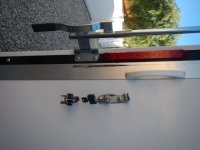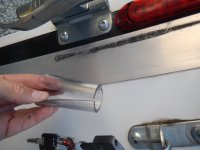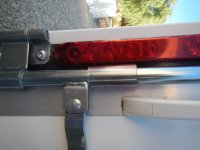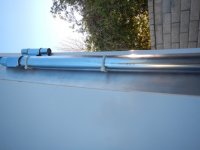So I finally paid attention to why my hands started having black on them every time I handled the rear door. Seems that the aluminum of the locking handles are rubbing thru the door frame. So I found a fix for now, however I'm sure there must be a way to improve on it. So any suggestions are appreciated.
Here is the door and the wear spots.


What I did was I found some 1"id clear hose from Lowes and slit it down the middle. Then slid it on the handles. Unfortunately I ended up securing it with tie wraps. I'm not sure how long they are going to last. I'm not so worried about water getting trapped but who knows.
These photos show just some scrap pieces of the tubing. I used 41" on each arm with 4ea. Tie wraps.



While this should work and hopefully keep the wear down, I'm sure there must be a cleaner way to make this work. Any suggestions? One thought I was thinking about is cutting the tubing into smaller sections of "pads", maybe 4" x 1" wide and use some silicone and glue that to the latching tubes.
Thanks
Doug
Here is the door and the wear spots.


What I did was I found some 1"id clear hose from Lowes and slit it down the middle. Then slid it on the handles. Unfortunately I ended up securing it with tie wraps. I'm not sure how long they are going to last. I'm not so worried about water getting trapped but who knows.
These photos show just some scrap pieces of the tubing. I used 41" on each arm with 4ea. Tie wraps.



While this should work and hopefully keep the wear down, I'm sure there must be a cleaner way to make this work. Any suggestions? One thought I was thinking about is cutting the tubing into smaller sections of "pads", maybe 4" x 1" wide and use some silicone and glue that to the latching tubes.
Thanks
Doug
